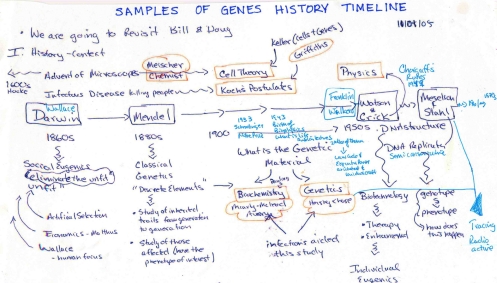Figure 1.
Example of a class-constructed genetics timeline. This image was constructed in one class session of an introductory genetics course in which students were asked to integrate the people, history, and experiments that led to an understanding of DNA as the transforming material. Events and publications from physics, chemistry, and biology are woven together; common techniques of the time are highlighted, including the use of radioactivity to trace molecules undergoing various molecular processes. The nod to “Bill and Doug” refers to a parable that helps students discern the differences between biochemical and genetic approaches and the merits of both in solving problems (Kellogg, 1994; Sullivan, 1993). There is a strong emphasis on the social ills of the time that drove discovery including infectious diseases (Griffiths, Hershey-Chase, Koch's Postulates), and attention is given to less-known figures such as Meischer, Franklin, and Wallace.

